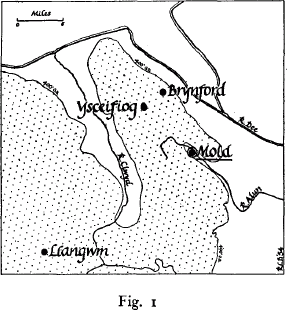The ornamental piece of sheet-gold found near Mold, in the county of Flint, North Wales (fig. 1), is one of the largest and heaviest pieces of prehistoric gold-work so far discovered in Europe, and it has been one of the principal treasures in the collection of prehistoric antiquities in the British Museum for more than a century.

Although the object has been frequently illustrated, no detailed study has been made of it since the original publication of its finding which appeared in Archaeologia in 1836.
In the present study an endeavour is made to restate the circumstances of the discovery, to offer a detailed description of the object itself, and to put forward certain views as to its age and use.
The gold ornament was discovered in 1833 during the destruction of a mound of stones and earth situated in a field named Bryn yr Ellyllon which lay about half a mile E.S.E. of the parish church of Mold, Flintshire. There are three early accounts of the discovery, but none of them are at first hand. They have been brought together by Canon Ellis Davies, and the fullest and most objective of these accounts is the second reproduced by him. In this, which was by the then Vicar of Mold, Rev. C. B. Clough, a fairly clear idea is obtained of the circumstances of the discovery, but it must be emphasized that the actual opening of the grave was not witnessed by him or by any of the other writers. The following reconstruction of, and commentary on, the discovery is, however, mainly based on the Vicar's account.